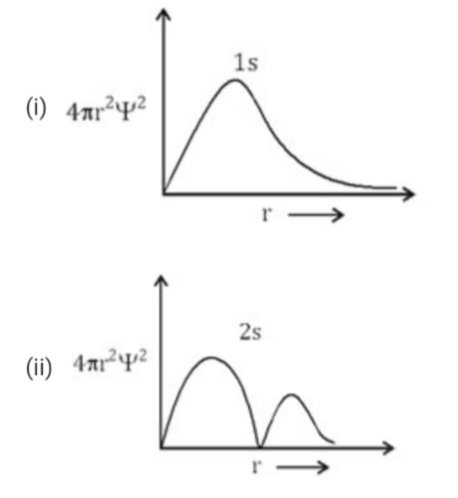The wave function orbital of H-like atoms is given as order
ψ2s=14√2πZ3/2(2−Zr)eZr/2
Given that the radius is in Å then which of the following is the radius for nodal surface for HeΘ ion ?
1Å
2Å
2.5Å
4Å
To find the radius for the nodal surface for the He⁺ ion using the given wave function orbital for H-like atoms, we can follow these steps:
Step 1: Understand the Wave Function
The wave function for the 2s orbital is given as:
ψ2s=14√2πZ3/2(2−Zr)e−Zr2
For nodal surfaces, the wave function must equal zero.
Step 2: Set the Wave Function to Zero
At the nodal surface, we set the wave function equal to zero:
ψ2s=0
This implies:
14√2πZ3/2(2−Zr)e−Zr2=0
Since the exponential term e−Zr2 is never zero, we focus on the term 2−Zr.
Step 3: Solve for the Radius
Set the term 2−Zr equal to zero:
2−Zr=0
This leads to:
Zr=2
From this, we can solve for r:
r=2Z
Step 4: Substitute the Atomic Number for He⁺
For the He⁺ ion, the atomic number Z is 2. Substitute Z=2 into the equation:
r=22=1 Å
Final Answer
The radius for the nodal surface for the He⁺ ion is:
1 Å
---
The wave function for the 2s orbital is given as:
ψ2s=14√2πZ3/2(2−Zr)e−Zr2
For nodal surfaces, the wave function must equal zero.
At the nodal surface, we set the wave function equal to zero:
ψ2s=0
This implies:
14√2πZ3/2(2−Zr)e−Zr2=0
Since the exponential term e−Zr2 is never zero, we focus on the term 2−Zr.
Set the term 2−Zr equal to zero:
2−Zr=0
This leads to:
Zr=2
From this, we can solve for r:
r=2Z
For the He⁺ ion, the atomic number Z is 2. Substitute Z=2 into the equation:
r=22=1 Å
The radius for the nodal surface for the He⁺ ion is:
1 Å
Topper's Solved these Questions
- ATOMIC STRUCTUREBOOK - CENGAGE CHEMISTRY ENGLISHCHAPTER - ATOMIC STRUCTUREEXERCISE - Exercises (Subjective)
52 Videos
- ATOMIC STRUCTUREBOOK - CENGAGE CHEMISTRY ENGLISHCHAPTER - ATOMIC STRUCTUREEXERCISE - Exercises Linked Comprehension
50 Videos
- APPENDIX - INORGANIC VOLUME 1BOOK - CENGAGE CHEMISTRY ENGLISHCHAPTER - APPENDIX - INORGANIC VOLUME 1EXERCISE - chapter-7 Single correct answer
1 Videos
- CHEMICAL BONDING AND MOLECULAR STRUCTUREBOOK - CENGAGE CHEMISTRY ENGLISHCHAPTER - CHEMICAL BONDING AND MOLECULAR STRUCTUREEXERCISE - Archives Subjective
15 Videos
Similar Questions
The wave function orbital of H-like atoms is given as onder
ψ2s=14√2πZ3/2(2−Zr)Zr/2
Given that the radius is in Å then which of the following is the radius for nodal surface for HeΘ ion ?
View SolutionA wave function for an atomic orbital is given as Ψ2,1,0 Recogine the orbital
View SolutionConsider ψ (wave function) of 2s atomic orbital of H-atom is-
ψ2s=14√2πa3/20[2−ra0]e.r2a0
Find distance of radial node from nucleous in terms of a0
View SolutionConsider ψ (wave function) of 2s atomic orbital of H-atom is-
ψ2s=14√2πa3/20[2−ra0]e.r2a0
Find distance of radial node from nucleous in terms of a0
View Solution(a) The wave function of an electron in 2s orbital in hydrogen atom is given below:
ψ2s=14(2π)1/2(za0)3/2(2−ra0)exp(−r/2a0)
where a0 is the radius. This wave function has a radial node at r=r0. Express r0 in terms of a0.
(b) Calculate the wavelength of a ball of mass 100g moving with a velocity of 100ms−1.
View SolutionThe Schrodinger wave equation for hydrogen atom is Ψ2s=14√2π(1a0)3/2(2−ra0)e−r/a0 , where a0 is Bohr's radius . If the radial node in 2s be at r0 , then r0 would be equal to :
View SolutionThe bohr radius is given by a0=ε0h2πme2 verify that the RHS has dimesions of length
View SolutionIf the radius of the second orbit of hydrogen atom is a Å then radius of the first orbit of Li2+ ion (in Å ) will be
View SolutionThe radius of the first orbit of H-atom is r. then the radius of the first orbit of Li2+ will be:
View SolutionWhich of the following plots of radial - probability function 4π2ψ2 is /are correct


View Solution
